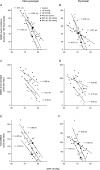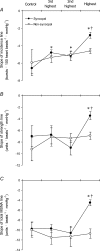Modulation of the control of muscle sympathetic nerve activity during severe orthostatic stress
- PMID: 16916904
- PMCID: PMC1890418
- DOI: 10.1113/jphysiol.2006.117507
Modulation of the control of muscle sympathetic nerve activity during severe orthostatic stress
Abstract
We tested the hypothesis that arterial baroreflex (ABR)-mediated beat-to-beat control over muscle sympathetic nerve activity (MSNA) is progressively modulated as orthostatic stress increases in humans, but that this control becomes impaired just before the onset of orthostatic syncope. In 17 healthy subjects, the ABR control over MSNA (burst incidence, burst strength and total MSNA) was evaluated by analysing the relationship between beat-to-beat spontaneous variations in diastolic blood pressure (DAP) and MSNA during supine rest (control) and during progressive, stepwise increases in lower body negative pressure (LBNP) that were incremented by -10 mmHg every 5 min until presyncope (nine subjects) or -60 mmHg was reached. (1) The linear relationships between DAP and burst strength and between DAP and total MSNA were shifted progressively upward as LBNP increased until the level at which syncope occurred. The relationship between DAP and burst incidence, however, gradually shifted upward from control only to LBNP = -30 mmHg; there was no further upward shift at higher LBNPs. (2) Although the slope of the relationship between DAP and burst strength and between DAP and total MSNA remained constant at all LBNPs tested, except at the level where syncope occurred, the slope of the relationship between DAP and burst incidence was reduced at LBNPs of -40 mmHg and higher (versus control). (3) In syncopal subjects, the slopes of the relationships between DAP and burst incidence, burst strength, and total MSNA were all substantially reduced during the 1-2 min period prior to the onset of syncope. Taken together, these results suggest baroreflex control over MSNA is progressively modulated as orthostatic stress increases, so that its sensitivity is substantially reduced during the period immediately preceding the severe hypotension associated with orthostatic syncope.
Figures



Similar articles
-
Modulation of control of muscle sympathetic nerve activity during orthostatic stress in humans.Am J Physiol Heart Circ Physiol. 2004 Nov;287(5):H2147-53. doi: 10.1152/ajpheart.00215.2004. Am J Physiol Heart Circ Physiol. 2004. PMID: 15475533
-
Attenuated cardiac baroreflex in men with presyncope evoked by lower body negative pressure.Clin Sci (Lond). 2001 Mar;100(3):303-9. Clin Sci (Lond). 2001. PMID: 11222117
-
Time-dependent modulation of arterial baroreflex control of muscle sympathetic nerve activity during isometric exercise in humans.Am J Physiol Heart Circ Physiol. 2006 Apr;290(4):H1419-26. doi: 10.1152/ajpheart.00847.2005. Epub 2005 Nov 11. Am J Physiol Heart Circ Physiol. 2006. PMID: 16284234 Clinical Trial.
-
Sympathetic nerve activity in hypotension and orthostatic intolerance.Acta Physiol Scand. 2003 Mar;177(3):359-65. doi: 10.1046/j.1365-201X.2003.01081.x. Acta Physiol Scand. 2003. PMID: 12609007 Review.
-
Bursting into space: alterations of sympathetic control by space travel.Acta Physiol Scand. 2003 Mar;177(3):299-311. doi: 10.1046/j.1365-201X.2003.01073.x. Acta Physiol Scand. 2003. PMID: 12609000 Review.
Cited by
-
The reciprocal relationship between cardiac baroreceptor sensitivity and cerebral autoregulation during simulated hemorrhage in humans.Auton Neurosci. 2022 Sep;241:103007. doi: 10.1016/j.autneu.2022.103007. Epub 2022 Jun 11. Auton Neurosci. 2022. PMID: 35716525 Free PMC article. Review.
-
Validation of lower body negative pressure as an experimental model of hemorrhage.J Appl Physiol (1985). 2014 Feb 15;116(4):406-15. doi: 10.1152/japplphysiol.00640.2013. Epub 2013 Dec 19. J Appl Physiol (1985). 2014. PMID: 24356525 Free PMC article.
-
Cardiac and Vascular Sympathetic Baroreflex Control during Orthostatic Pre-Syncope.J Clin Med. 2019 Sep 10;8(9):1434. doi: 10.3390/jcm8091434. J Clin Med. 2019. PMID: 31510103 Free PMC article.
-
Resting sympathetic baroreflex sensitivity in subjects with low and high tolerance to central hypovolemia induced by lower body negative pressure.Front Physiol. 2014 Jun 30;5:241. doi: 10.3389/fphys.2014.00241. eCollection 2014. Front Physiol. 2014. PMID: 25071587 Free PMC article.
-
Menstrual cycle effects on sympathetic neural responses to upright tilt.J Physiol. 2009 May 1;587(Pt 9):2019-31. doi: 10.1113/jphysiol.2008.168468. Epub 2009 Feb 23. J Physiol. 2009. PMID: 19237424 Free PMC article.
References
-
- Campagna JA, Carter C. Clinical relevance of the Bezold-Jarisch reflex. Anesthesiology. 2003;98:1250–1260. - PubMed
-
- Charkoudian N, Eisenach JH, Joyner MJ, Roberts SK, Wick DE. Interactions of plasma osmolality with arterial and central venous pressures in control of sympathetic activity and heart rate in humans. Am J Physiol. 2005;289:H2456–H2460. - PubMed
-
- Charkoudian N, Martin EA, Dinenno FA, Eisenach JH, Dietz NM, Joyner MJ. Influence of increased central venous pressure on baroreflex control of sympathetic activity in humans. Am J Physiol. 2004;287:H1658–H1662. - PubMed
-
- Convertino VA, Ludwig DA, Cooke WH. Stroke volume and sympathetic responses to lower-body negative pressure reveal new insight into circulatory shock in humans. Auton Neurosci. 2004;111:127–134. - PubMed
Publication types
MeSH terms
LinkOut - more resources
Full Text Sources
Medical

